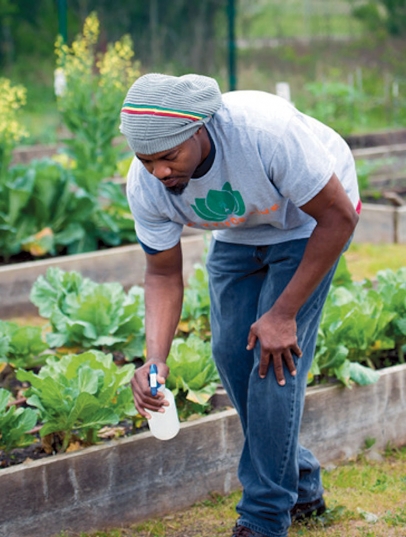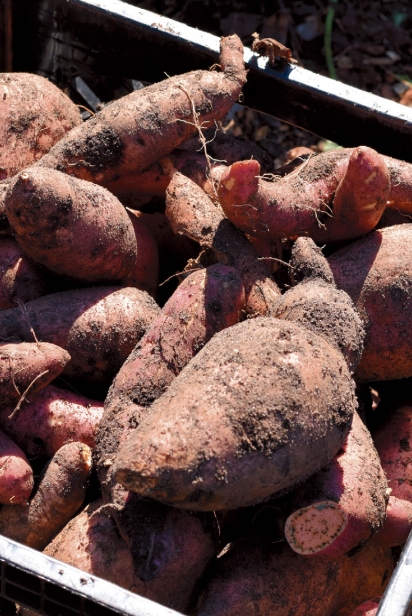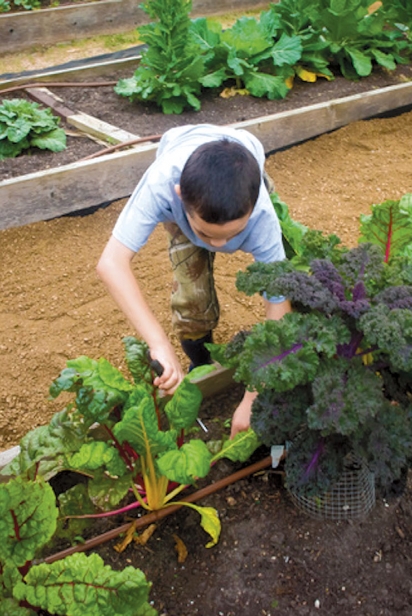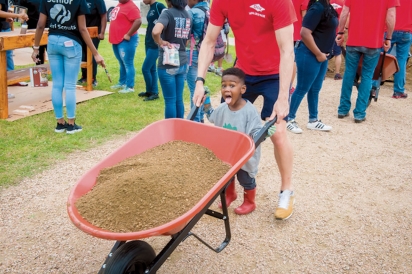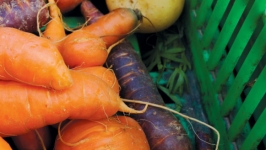Growing Resilience Community Gardens Offer Connection During the Pandemic
Beauty’s Community Garden is bustling with activity as volunteers pull weeds, water beds and harvest sweet potatoes. Yvette Leno, the garden’s founder, looks on. She had envisioned this when she started the garden some eight years ago at the site of her Independence Heights childhood home. A fire destroyed the house and, in searching for what to do with the land, Leno decided to address food insecurity in her neighborhood.
“Gardening ties to everything concerning the health and well-being of our community,” said Leno on this recent Saturday morning. “After the garden started and I saw buy-in from various groups and I learned about community building, I thought: ‘I want the garden to be able to bring people together and I want it to uplift and beautify the community.’”
Aside from providing direct access to fresh foods, often in areas with high indices of food insecurity, community gardens play an important role in educating people and strengthening community ties. The COVID-19 crisis has magnified that role.
When the pandemic struck last spring, Leno and a small group of core volunteers stopped going to the garden. It filled with weeds, but they went back, taking precautions like distancing and wearing masks, and now they have more volunteers than they’ve ever had before.
“Since the virus, people want to get out and do something, they want to see other people, and since it’s a safe environment, they’re very happy to come to the garden,” said Sam Nuckol, a longtime garden volunteer at Beauty’s.
Volunteers at the garden that Saturday morning cited extra time due to the pandemic, an interest in learning about growing food, or wanting to do a safe social activity as the reasons that brought them there. According to Meagan Terry, community gardens manager for Urban Harvest, gardeners in the organization’s affiliate network have seen an increase in participation and interest since the onset of the pandemic.
Urban Harvest conducted a COVID-19 needs assessment in April and found that volunteers were gardens’ top need, followed by materials and resources. In response, the organization moved its educational programming online, distributed free materials, and launched a volunteer platform to connect volunteers with nearby community gardens. Some popular gardens received so much interest that they asked to be removed from the platform.
But that wasn’t the case for all gardens. Seventy of the 140 gardens in Urban Harvest’s affiliate network are in schools, which closed due to the coronavirus, leaving teachers, students and volunteers without access to them. “Usually they had 135 fifth graders who were coming out to the garden every week to maintain it and then there was no one. That was the toughest adjustment,” said Terry. “A lot of our other gardens stayed the same because actually people were spending more time outside.”
Kellie Karavias, a culinary educator who runs the Cultivated Classroom garden at Gregory Lincoln Education Center in Houston’s Fourth Ward, had to go virtual overnight. And she was unable to do much of the work that she, along with volunteers, did over the summer. “Our garden went from looking amazing to looking overrun,” she said.
But Karavias, like the other gardeners, saw a growing need for gardening education and an interest in growing food due to fears of food insecurity. It may seem like a distant memory, but early in the pandemic, people didn’t want to go to a grocery store and if they did, many foods were unavailable. This, according to gardeners, created a sense of urgency and a need for resources and education.
For families whose community gardens were in schools, Urban Harvest piloted a summer Grow Kit program. Karavias participated, distributing kits to children who receive SNAP benefits. The kits included a cloth grow bag, soil, transplants, seeds, fertilizer, and educational resources. “Kids were really excited about the Grow Kits and that was a great testament of when you think that something so little doesn’t mean so much,” said Karavias.
The kits became like an extension of the community garden at home. They got kids outside, families engaged, and connected to growing local foods. “All this was virtual and it was a way to connect families across Houston,” said Urban Harvest’s Terry. “Because of barriers to going outside or congregating with big groups, it was a neat way to bring the garden home.”
Urban Harvest has continued distributing Grow Kits. In October, they distributed close to 900, including at virtual learning centers. The program has also generated interest from senior centers and other community organizations.
School closures also affected community gardens who relied on student volunteers. At Lettuce Live Urban Farm in Missouri City, a one-quarter-acre garden run by Karena Poke, beds of okra, sweet potatoes, lettuces, herbs and peppers are numbered with wooden signs painted by local students. High school senior Stefanie Penado harvests sweet potatoes from one of the beds along with a friend. She volunteered at Lettuce Live because she needed community service hours, but she has continued coming to the garden. It has become an outlet to counter the stress of her virtual AP classes.
Before the pandemic hit, Poke relied heavily on high school and college students like Stefanie who needed to earn community service hours to maintain the garden. When schools closed down, many of those volunteers stopped coming, leaving Poke and two volunteers to tend to the garden over the summer. She canceled the STEM camp she had planned for the summer.
But things have slowly picked up. Some student volunteers like Stefanie have continued volunteering, and as the summer ended, people started showing interest in the garden’s produce. Poke uses the interest in her produce as an opportunity to inspire people to grow food. “My real interest is in, how can I get you to grow some produce?” Poke said.
Poke is working on a series of videos and activities for homeschoolers and children learning at home. She also welcomes companies that want to do some team building at the garden. Since the space is outside and there is plenty of space to distance, people can safely work on small projects together.
“Community is not always about waiting for someone to say, ‘I have a need.’ Sometimes, community is about saying ‘Hey, I have this. Do you need it?’” said Poke.
Like so many of us during this pandemic, gardeners have adapted to the current situation. Philippa Johnstone, who works with Leno at Beauty’s Community Garden, said she felt empowered by how their team regrouped and reorganized. They’re working to change the layout of the garden so they can host small gatherings, they continue to grow produce to donate to senior homes and local food pantries, and they have plans for a youth food entrepreneurship program.
“While the virus gave us some curveballs in the sense that we couldn’t be at the garden as much, it gave us that push to come together during a crisis and decide how to move forward,” said Johnstone.
In their latest survey of affiliate gardens, Urban Harvest found that most had not been negatively affected by COVID-19. By all accounts, Houston’s community gardens are growing resilience amidst a pandemic that has hit some communities hard by increasing food access and offering a space for people to reconnect with their neighbors, the earth, and the food that they eat.
Said Johnstone: “There was been so much going on that people are taking a second look at what purpose they feel they can provide and what service they can give back to the community and to the world in general.”
TO FIND OUT MORE ABOUT THE FOLKS FEATURED IN THIS ARTICLE, VISIT:


